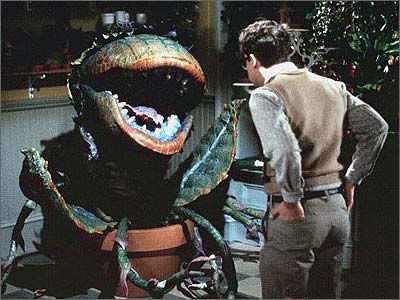

The largest meat-eating plant in the world is designed not to eat small animals, but small animal poo.
Botanists have discovered that the giant montane pitcher plant of Borneo has a pitcher the exact same size as a tree shrew's body.
But it is not this big to swallow up mammals such as tree shrews or rats.
Instead, the pitcher uses tasty nectar to attract tree shrews, then ensures its pitcher is big enough to collect the feeding mammal's droppings.
Details of the discovery are published in the journal New Phytologist.
Big reputation
Pitcher plants have elaborate structures which entice creatures such as ants or spiders into a precarious position, from which they fall into a fluid-filled trap, where they drown and are ingested.
These arthropods are thought to provide the plant with vital nitrogen and phosphorus, which it cannot obtain any other way.
Pitchers are the largest carnivorous plants, and the largest pitchers grow in Borneo.
One, known as Nepenthes rajah, is believed to be the largest meat-eating plant in the world, growing pitchers that can hold two litres of water if filled to the brim.
This plant's pitcher is so big that they are reputed to catch vertebrates.
"This species has always been famous for its ability to trap rodents, but I've been looking at the pitchers of this species on and off since 1987, and I've never seen a trapped rat inside," says Dr Charles Clarke, an expert on carnivorous plants based at Monash University's Sunway Campus in Selangor, Malaysia.
"This made me wonder: if it is large enough to trap rats, but it only traps them very rarely, it is likely that the pitchers are large because of some other reason?"
To find out, Dr Clarke and colleagues Ms Lijin Chin of Monash University and Dr Jonathan Moran of Royal Roads University in Victoria, British Columbia, Canada turned their attention to tree shrews, which inhabit the same forest as N. rajah.
They did so after noticing that tree shrews, which are a similar size to rodents but most closely related to primates, sometimes left faeces in the traps of large pitchers.
"All of a sudden we realised that there may be some relationship between big pitchers and tree shrews," says Dr Clarke.
"So we decided to look at the pitcher geometry."
What they found "totally blew us away", says Dr Clarke.
Precise dimensions
N. rapah pitchers have huge orifices, but they also grow large concave lids held at an angle of about 90 degrees away from the orifice.
The inside of these lids are covered with glands that exude huge amounts of nectar.
Most importantly, the distance from the front of the pitcher's mouth to the glands corresponds exactly to the head to body length of mountain tree shrews.
The same is true for two other species of large meat-eating pitcher plant, N. lowii and N. macrophylla that are also visited by tree shrews.
However, the pattern does not hold for other pitcher species not associated with the small mammals.
"In order for the tree shrews to reach the exudates, they must climb onto the pitchers and orient themselves in such a way that their backsides are located over the pitcher mouths," explains Dr Clarke.
The tree shrews then appear to defecate as a way of marking their feeding territory.
That suggests these supposedly "meat-eating" plants have evolved a mutualistic relationship with tree shrews.
The tree shrews get nectar, a valuable food source, and in return, the plants get to catch and absorb the tree shrew's faeces which likely supplies the majority of nitrogen required by the plant.
These particular species of pitcher also live in the highlands where insects and other arthropods are more scarce.
Such creatures would normally provide the nitrogen needed by the pitcher, forcing it to evolve its huge size to attract tree shrews instead.
Radical rethink
"150 years after the discovery of N. rajah, we finally have an explanation for why the largest carnivorous plant in the world produces such big pitchers," says Dr Clarke.
Dr Clarke says it is the "neatest" discovery he has made in more than 20 years of studying Nepenthes meat-eating plants.
"The findings should radically alter how we look at these plants," he says.
He believes there is much we still have to learn about the true habits of carnivorous plants.
They suspect another highland species, N. ephippiata, likely feeds on faeces too, as may a huge meat-eating plant called N. attenboroughii which was only discovered last year.
In the lowlands of Borneo, bats roost in the pitchers of yet more Nepenthes species, suggesting these plants may too feed off the faeces of other small mammals.
Story here

